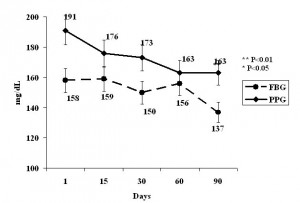What is Postprandial Blood Sugar?
For people with diabetes, the body does not make enough insulin to regulate blood sugar levels. As a result, blood sugar levels may be too high. Over time, consistently high blood sugar levels can lead to complications such as nerve, eye, kidney, and heart damage. Postprandial refers to after meals.
What is a postprandial blood sugar test?
Also known as a two-hour PPG test, a postprandial blood sugar test is done to see how the body responds to starch and sugar after a meal. As the body digests food in the stomach, blood sugar levels increase sharply. The pancreas responds by releasing insulin to help move glucose from the blood into cells of tissues such as muscles where it is used for energy or fuel. Two hours after eating, blood glucose and insulin levels should return to the normal range. However, if blood sugar levels remain high, it shows that you may have diabetes.
Why do you need the test?
In most cases, you may need a postprandial blood glucose level test if your physician wants to determine whether you have insulin-related disorders such as diabetes. Your healthcare provider may suggest this test if you have symptoms such as:
- Tiredness
- Frequent urination
- Sores and wounds that heal slowly
- Unusual thirst
- Blurred vision
- Repeated infections
For pregnant women, this test screens for gestational diabetes. Prompt treatment of gestational diabetes helps reduce risk for health problems for the mother as well as the baby.
Other tests that might be done with this test
In most cases, healthcare providers request other tests to evaluate or confirm diabetes diagnosis. These tests include:
- Fasting blood sugar test: This test measures blood sugar levels after at least 8 hours without eating (overnight fast).
- Glycosylated hemoglobin (A1C/HbA1c) test: Measures blood glucose levels over a period of about 3 months.
- Glucose tolerance test: This lab test checks how the body moves glucose from the blood into muscle, fat and other tissue.
What do the lab test results mean?
Results usually vary depending on various factors such as the test method used, health history, gender, age, and other things. However, your test results do not necessarily mean you have a problem. Therefore, it is essential to consult your doctor about what the results mean specifically for you.
Results for postprandial blood sugar levels are usually displayed in mg/dL (milligrams per deciliter) and normal test results are:
- For non-diabetics: below 140 mg/dL
- For people with diabetes: below 180 mg/dL
In case your blood sugar level is still high 2 hours after eating, it indicates that you may have diabetes or prediabetes.
Factors that may affect postprandial blood sugar test results include:
- Extreme stress
- Smoking during the test period
- Eating candy or snacks just before being tested
- Working out just before you’re tested
- Inability to eat as recommended
Notify your healthcare provider about all supplements, medicines, vitamins, and herbs you’re taking. This includes all illegal drugs as well as medications that don’t require a prescription.
Knowing your postprandial blood glucose levels gives you control over your condition

Measuring PPG helps determine whether pre-meal bolus insulin or dietary modifications are needed to reduce spikes. PPG therapy and monitoring is recommended for patients whose A1C levels remain above target even after achieving their pre-meal blood glucose targets.
Who should check postprandial blood sugar levels?
Your specific condition as well as your blood sugar level goals help determine how often PPG tests should be done. Your healthcare team can help you determine your target goals and testing regimen. According to the ADA, certain people should test blood sugar and PPG levels more frequently, these include:
- Pregnant women with type 1 or type 2 diabetes
- Pregnant women diagnosed with gestational diabetes
- Patients who are trying a new insulin dosage or new insulin
- People with uncontrolled diabetes
- People who are under multiple medications
- People who are at risk of low or high blood sugar
Carbohydrates make a higher contribution to postprandial blood sugar levels than the protein and fat content of a meal. Checking PPG on a regular basis helps you determine the best balance of proteins, fats, and carbohydrates. Therefore, it’s essential to learn how to count carbs in a bid to achieve your blood sugar level goals, especially after eating.


